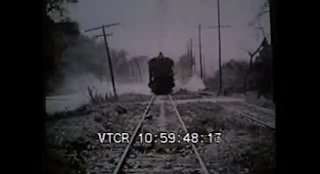Alright, so my assignment for today is to compare two short
films and the style of film making involved in making them. These films are “Arrival
of a Train” and “Damsel in Distress”. Both of these were made in the time where
everything was funny, and everyone dressed way too heavily for the weather. But
enough bad jokes, here comes the analysis of the two.
1. “Arrival of a Train” is shot from an angle that allows the viewer a good view of everything going on along the platform. This angle does not change, and there is no movement, so no one character is focused on and you are treated to a look at everyone at once. Captures the hustle and bustle of a train station very well this way. In “Damsel in Distress”, there is not much movement within shots, but the angles do change between them. Composition varies greatly between shots, compared to the “Arrival of a Train” where nothing changes camera-wise.
1. “Arrival of a Train” is shot from an angle that allows the viewer a good view of everything going on along the platform. This angle does not change, and there is no movement, so no one character is focused on and you are treated to a look at everyone at once. Captures the hustle and bustle of a train station very well this way. In “Damsel in Distress”, there is not much movement within shots, but the angles do change between them. Composition varies greatly between shots, compared to the “Arrival of a Train” where nothing changes camera-wise.
2. “Arrival of a Train” has no editing done to it, so it is
just one long continuous shot. This makes us focus on the scene as a whole
rather then on one specific character. However, everything going on in the shot
is relevant to the plot (which is pretty much the title of the short film). The
differences between the nonexistent editing in this film compared to “Damsel in
Distress” are, well, drastic. In that film the plot is carried by parallel
action, with the shots alternating between the woman and the dog. There are
also a lot of associative cuts, where the dog’s actions are shown in relation
to the woman’s position, showing us how it is affecting the situation and how
its actions matter.
3. In “Arrival of a Train” you see the plot through just one
view, with no specific character and no goal other than showcasing the train
arriving and the reaction of those around it. Time is continuous and so is the
setting. In “Damsel in Distress” there are set characters, a set obstacle/goal
(the saving of the woman and the train/inability for her to escape), a
suspenseful mood (the speed of the shots along with the constant alternating
between train and character)…every theme is showcased in this film, compared to
the first film where you only have a limited amount of information and no real
plot.



No comments:
Post a Comment